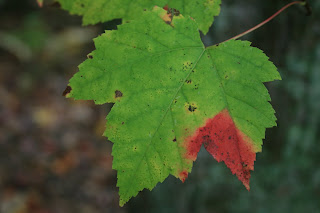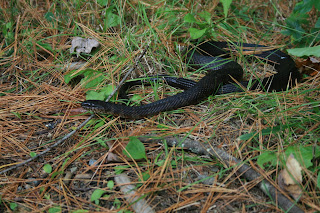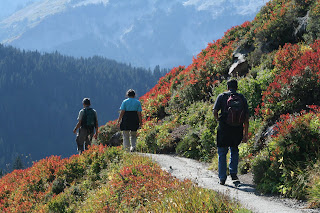
We arrived in Yosemite National Park a week ago today for a one night stay, driving nearly four hours from the San Francisco Bay Area. In the late 1860s, John Muir set off on foot on the same journey, discovering what he described as the "the grandest of all the special temples of Nature."
As part of a two-week west coast trip that included visits to Olympic, Mt. Rainier, and Crater Lake National Parks, Yosemite was our final Park. After experiencing the beauty, diversity, landscapes, and history of three National Parks, we descended into Yosemite Valley with the same anticipation of entering another "temple of nature." And surely Yosemite is grand.
 Yosemite Valley from Inspiration Point, near the Wawona Tunnel;
Yosemite Valley from Inspiration Point, near the Wawona Tunnel;
El Capitan on the left; Half Done in the background
Yosemite has drawn visitors--now more than 3.5 million each year--to its valley since before its official establishment as a National Park in 1890. Even in late September the Park is full of people, coming to a place steeped in history, drawn to its granite cliffs, stunning vistas, massive trees, waterfalls (the tallest in the world), and wildlife.
 El Capitan, 3,600 feet above the valley floor,
El Capitan, 3,600 feet above the valley floor,
a climber's mountain
 Climbers on El Cap (in center of photo--click to enlarge)
Climbers on El Cap (in center of photo--click to enlarge)
Sitting comfortably down below in El Capitan Meadow
we watch through binoculars (some viewer's have spotting scopes)
in awe as climbers make the 4 to 8 day ascent.
The first ascent in 1958 took 43 days.
 Half Dome (8,842 feet)(although geologists say there is really more than 1/2 there!)
Half Dome (8,842 feet)(although geologists say there is really more than 1/2 there!)Accommodating millions of people a year takes its toll on Yosemite. To alleviate some traffic congestion and pollution, the Park operates hybrid electric diesel buses to shuttle people throughout the valley. The buses are convenient and comfortable and maybe someday will be or should be mandatory; people can still opt to drive everywhere. One of our bus drivers provided an informative interpretive tour as she drove from stop to stop, which she herself said was unusual as most other drivers are silent.

Yosemite has lots of overnight options. Camp 4 is the rustic (and probably rowdy and ripe) camp for climbers and their helpers. Yosemite Lodge and the Ahwahnee provide lodging at the upper end of comfort. We opted for Curry Village, with its maze of canvas tents, cabins, and other rooms.
With the spirit of an outdoor college dormitory setting, Curry Village is lively, busy, and surprisingly comfortable; perhaps too comfy. The canvas tents were outfitted with cots, sheets, warm wool blankets, towels, lights, bear locker for food, and a lock for the tent door. Down a dirt path a large clean bathroom and shower facility was as elegant as our home baths. An indoor meeting space offered free wireless internet access, tables for games or puzzles, soft chairs for reading. Another building in the complex housed a cafe, store, and the Pizza Deck -- we joined what seemed like everyone else in Curry Village for a darn good pizza.
The wildlife are tame in Yosemite. This may be an unfortunate result of too much human food discarded intentionally or unintentionally. Most people seem to miss the wildlife, or perhaps they are so accessible that they appear like just any other visitors. We enjoyed the antics of the birds and especially the squirrels and chipmunks.


 Yellow pine chipmunk (Tamias amoenus), always busy
Yellow pine chipmunk (Tamias amoenus), always busy
 California ground squirrel, Spermophilus beecheyi
California ground squirrel, Spermophilus beecheyi
 Western gray squirrel (Sciurus griseus), a bit shy
Western gray squirrel (Sciurus griseus), a bit shy Ravens (Corvus corax), big, black, bold, and beautiful
Ravens (Corvus corax), big, black, bold, and beautiful Steller's Jay (Cyanocitta stelleri), loud, bold, and beautiful
Steller's Jay (Cyanocitta stelleri), loud, bold, and beautiful
Yosemite is host to three groves of giant sequoias (
Sequoiadendron giganteum). Of the three, Mariposa Grove has the most big trees and is the most popular. So popular that the only brochures left in the kiosk were in French and German, the English versions had run out. As their name suggests, sequoias are huge, their size can barely be captured in photos.


One of the biggest in the grove is the "Grizzly Giant," over 200 feet tall and 31 feet in diameter at its base, it is estimated to be 2,700 years old. Given its girth and height, giant sequoia evergreen leaves and cones are surprisingly small. The cone is the size and shape of a large chicken egg.
 Giant sequoia leaves
Giant sequoia leaves
Giant sequoias are adapted to fire, germinating from seed in mineral soil exposed to full sunlight and free of competing vegetation. Decades of fire suppression have helped shade tolerant firs and cedars out-compete the sequoias. The Park Service now sets fires purposefully to help the sequoias germinate. At Mariposa Grove a park naturalist was thrilled to point out a year-old prescribed fire that was visible along the trail. The firs and cedars killed, mineral soil exposed, and tiny sequoias emerging. Although the sequoias were also burned, their 2-foot thick bark protects them from serious injury.

Other species depend on the dead trees that result from fire or help with seed dispersal. We caught sight of the beautiful white-headed woodpecker and the more common Douglas's squirrel chattered as we walked by.
 White-headed woodpecker, Picoides albolarvatus
White-headed woodpecker, Picoides albolarvatus

 Douglas Squirrel, Tamiasciurus douglasii
Douglas Squirrel, Tamiasciurus douglasiiWe were on our trip, and so caught only glimpses, just as the documentary on PBS by Ken Burns --
The National Parks: America's Best Idea debuted. Instead we were experiencing it live, and yes it is American's best idea.
 As a fan of chocolate, Halloween always challenged my self-discipline. I remember as a kid spreading out the night's haul on a card table and trading big (and they were big back then) candy bars with my brother. We were always a bit tentative visiting the neighbor that handed out raisins and other healthy foods. Not that we were afraid of these "treats," we were just on the hunt for candy, and lots of it.
As a fan of chocolate, Halloween always challenged my self-discipline. I remember as a kid spreading out the night's haul on a card table and trading big (and they were big back then) candy bars with my brother. We were always a bit tentative visiting the neighbor that handed out raisins and other healthy foods. Not that we were afraid of these "treats," we were just on the hunt for candy, and lots of it.



























































